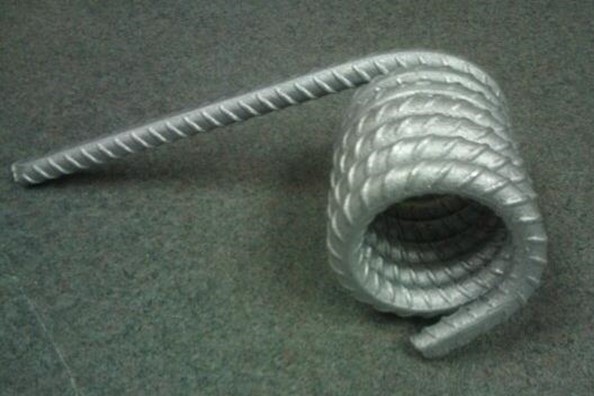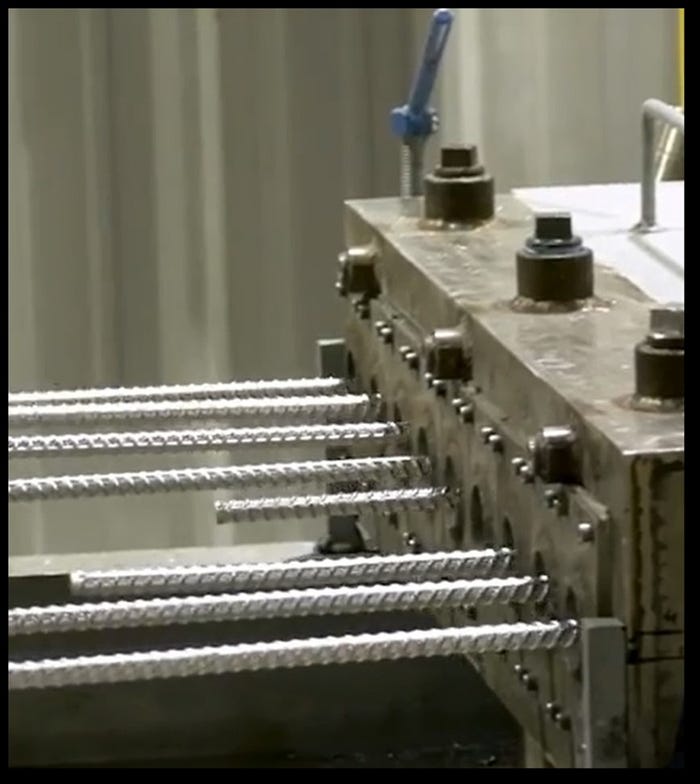Galvanized Rebar’s Time Has Come
Galvanized reinforcing steel has superior corrosion resistance to epoxy coated steel but the price differential has prevented widespread use in the U.S. Now, a new system called continuously galvanized rebar (CGR) has become available that overcomes that price differential while maintaining the life cycle advantage of 100 years.
October 16, 2020

Corrosion of reinforcing steel is the greatest weakness of reinforced concrete used for infrastructure. Rusted or exposed rebar is an embarrassment to the concrete industry. The methods used to prevent this flaw include low permeability concrete; thick concrete cover over the steel bars; the use of stainless steel, carbon fiber, or basalt rebar; epoxy coating of rebar; and hot-dip galvanized rebar. For the past 50 years or so, the use of epoxy coating has been the dominant technique used and in general it has performed well although its 50-year life expectancy is coming due and some failures are being identified.
Galvanized reinforcing steel has superior corrosion resistance to epoxy coated steel and has been used in some structures, including the Sydney Opera House, but the price differential has prevented widespread use in the U.S. Now, a new system of galvanizing reinforcing steel has become available that overcomes that price differential while maintaining the life cycle advantage of 100 years. This technique is called continuously galvanized rebar (CGR) and an Oklahoma company, CGR Systems, has developed equipment to economically produce this product.

In a recent interview, the inventors of this equipment, Russell Patterson and Chris Mason, described why CGR could become the preferred corrosion-resistant reinforcing steel in the U.S.
Hot-dipped galvanized (HDG) rebar has not been used in the U.S. mostly because it is more expensive than epoxy-coated rebar. But HDG has a 100-year life compared to only 50 years for epoxy coated bars. CGR is an even better coating than HDG at a price that is equal to or less than epoxy coating.
Standard hot dip galvanizing uses virtually pure zinc with the addition of alloys such as aluminum (0.002%), nickel (0.04%), tin (0.1% max), lead, and bismuth but not exceeding 1% combined. Traditionally rebar is hot dip galvanized by dipping bundles of straight rebar or fabricated cages of rebar after first being degreased, pickled, and flux coated. By contrast, CGR coating is applied in a continuous automated process. Our equipment can process nine bars simultaneously in 20-, 40-, or 60-foot lengths. The bars are first blasted, flux coated, preheated, quenched and passivated, and unloaded automatically, all in one straight line. The CGR process uses approximately 0.3% aluminum and 99.7% pure zinc. A traditional HDG coating on rebar is typically 132 microns thick while the CGR process produces an essentially pure zinc coating at 50 microns.
CGR produces a ductile coating while maintaining the advantages of an HDG coating. CGR has the added benefit of allowing the fabrication of rebar cages after galvanizing, either in the shop or in the field. CGR can be bent or cut in the field. The CGR coating behaves in a similar manner to conventional coatings and affords cathodic protection in the event of scratches and chipping when the base steel is exposed. There are no special requirements for storage on site.
With HDG, entire rebar cages are often fabricated then galvanized. With CGR, that’s not necessary since the thinner coating is more malleable and ductile and can be bent in the shop or in the field without disrupting or fracturing the galvanizing layer. Cut ends or welded areas can be sprayed with a zinc-rich paint although that’s not necessary for smaller bars since the zinc is self-sacrificial. Chairs and ties similarly do not need to be galvanized, although sometimes the engineer may require that they are.
Another advantage of using CGR is that since corrosion is not an issue, the concrete cover can be thinner, which results in a lighter weight structure. Bond strength of CGR in concrete is significantly great than with black steel based on studies at the University of California.
CGR was invented through university research. We designed and built equipment that can produce CGR at high productivity and cost efficiency. We’ve had the equipment in operation now for about 2 years. It has been used on some bridge decks.
The only company currently manufacturing CGR is AZZ in Catoosa, Oklahoma, under the trade name GalvaBar. Our equipment is available, though, to rebar manufacturers or fabricating shops.
This new galvanized coating could provide an answer to how to produce resilient reinforced concrete at an affordable price, something that would be a great benefit to our industry. To learn more about CGR Systems, go their web site: http://cgrsystemsllc.com/ .
You May Also Like


